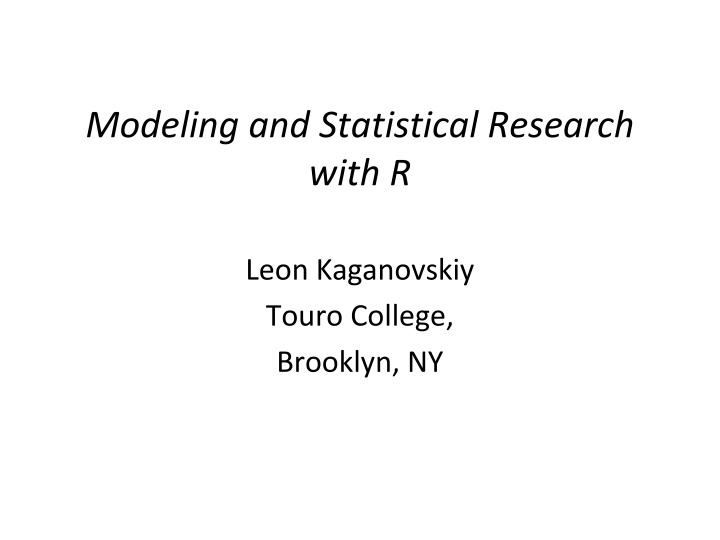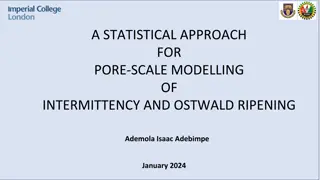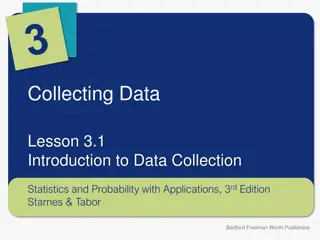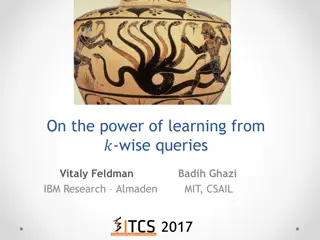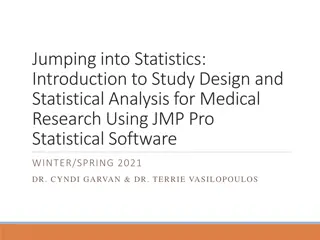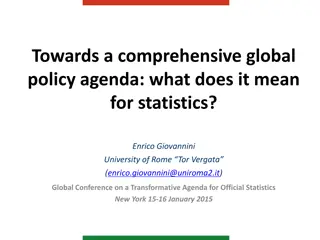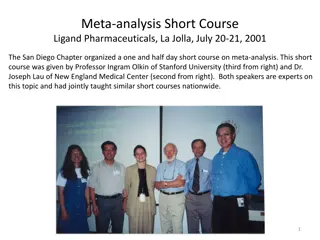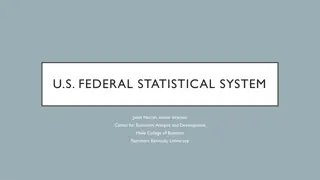Modeling and Statistical Research with R - Comprehensive Overview
In this research guide, discover the potential of R for data analysis, statistics, and scientific computing. Explore textbooks, research papers, and projects covering various disciplines. Gain insights into R's capabilities, specialized packages, and applications for students and researchers alike. Delve into topics like principal components, power analysis, data visualization, and more. Enhance your understanding of statistical modeling and research methodologies with R.
Download Presentation

Please find below an Image/Link to download the presentation.
The content on the website is provided AS IS for your information and personal use only. It may not be sold, licensed, or shared on other websites without obtaining consent from the author.If you encounter any issues during the download, it is possible that the publisher has removed the file from their server.
You are allowed to download the files provided on this website for personal or commercial use, subject to the condition that they are used lawfully. All files are the property of their respective owners.
The content on the website is provided AS IS for your information and personal use only. It may not be sold, licensed, or shared on other websites without obtaining consent from the author.
E N D
Presentation Transcript
Modeling and Statistical Research with R Leon Kaganovskiy Touro College, Brooklyn, NY
Table of contents: Introduction: What is R? Textbooks Research paper with Prof Kidron (Psychology) Research paper with Prof Lowman (Ecology) Research with Prof Rumain (Psychology) Summary
What is R? R is a Free!!!! Coherent, flexible system for data analysis that can be extended via thousands of specialized packages. R is as suitable for students learning statistics as it is for researchers using statistics. Allows for an early exposure to Scientific Computing
Textbooks: R. Kabacoff, R in Action 2nd Ed - intro to intermediate level - describes a principal components, power, repeated measures, clustering, ggplot last chapter etc QuickR Shahbaba, Biostatistics with R introductory level relying on R-commander. Only basic topics, no repeated measures, principal components, etc (Chen & Pierce Clinical Trials) Field, Discovering Statistics Using R intermediate to advanced (Psychology), ggplot, repeated measures, principal components, multivariate design, etc - encyclopedic. Crawley, Statistics: Introduction Using R and The R book starts with Data Frames, data summaries, ANOVA, ANCOVA, Regression, Contrasts (best), Cluster trees, no ggplot, older. Pace, Beginning R 2nd Ed intro to intermediate, compact, but covers ggplot, more complex repeated and mixed ANOVA, Multivariate Regression, Non-parametric tests and Bootstrap. Mosaic Project Student Guide -- gf_ formula design linking to ggplot2 Hastie, Tibshirani etc, Intro Statistical Learning intermediate (Actuary Exam) Larsen, Marx, Math Statistics Theory chosen by Actuary colleagues for exam (simulations). Jones, Millard, and Robinson, Scientific Programming and Simulation Sci Computing course. Chapman, Marketing Analytics using R. interesting examples, topics. Wickham, R for Data Science - dplyr package for data handling. Mostly Computer Science approach, no modelling, very clever data processing, works for BIG data. Ismay and Kim (Data Camp), Intro Statistics Data R intro level to dplyr and pipe based bootstrapped confidence intervals, p-values, regression inference etc
Mosaic Project Student Guide - Consistently extends formula notation ~ from lm() to all computations and graphics (NEW: ggplot with gf_plottype(formula, data = mydata)) One quantitative variable mean(~ cesd, data=HELPrct), sd(), median(), favstats() (cesd depression score) gf_histogram(~ cesd | sex, data = HELPrct, col="black", binwidth = 5.9) Female <- filter(HELPrct, sex=='female ) -- introduce data verbs like filter(), select, and pipes %>% early. gf_dhistogram(~ cesd, data = Female, col="black", binwidth = 7.1) %>% gf_fitdistr(dist = "dnorm")
t.test(~ cesd), confint() - confidence interval and tests for one sample against H0: = 0 Resampling and bootsrapping trials <- do(1000) * mean(~ cesd, data=resample(Female)) One categorical variable: tally(~ sex, data=HELPrct), prop.test(), xchisq.test(observed, p=p) Two quantitative variables (standard use of formula notation even in base R): model = lm(cesd ~ mcs, data=females), histogram(~ residuals(model), density=TRUE) gf_point(cesd ~ mcs, data = HELPrct) %>% gf_lm(interval = "confidence", fill = "red") %>% gf_lm(interval = "prediction", fill = "blue", alpha = 0.1) Linear model with confidence and prediction bands
Two categorical variables: require(gmodels) CrossTable(homeless, sex,format="SPSS ,data=HELPrct)) mytab <- tally(~ homeless + sex, margins=FALSE, data=HELPrct) mosaicplot(mytab)
Quantitative Response, Categorical Predictor even better use of formula notation gf_boxplot(cesd ~ sex, data = HELPrct) t.test(x~y, paired = TRUE, data = datafile) wilcox.test(cesd ~ sex, data=HELPrct) --NON-parametric tests Permutation shuffling test: rtest.stats <- do(500) * diffmean(age ~ shuffle(sex), data=HELPrct) pvalue = sum(rtest.stats$diffmean < test.stat) / length(rtest.stats$diffmean) > pvalue [1] 0.158
Quantitative Response, Categorical Predictor >2 groups => ANOVA - formula notation works same gf_boxplot(cesd ~ substance, data = HELPrct) Categorical Response, Quantitative Predictor - logistic regression logitmod <- glm(homeless ~ age + female, family=binomial, data=HELPrct) Two (or more) way ANOVA summary(aov(cesd ~ substance * sex, data=HELPrct)) Power of a test Data Management pipes %>%, data verbs: filter, select, arrange, mutate, summarize, etc
G. James, D. Witten, T. Hastie, R. Tibshirani An Introduction to Statistical Learning with Applications in R (free online) This book presents some of the most important modeling and prediction techniques, along with relevant applications. Lecture videos essential for teaching (especially longer theoretical sections). R labs are mostly presented by Trevor Hastie. Topics include: Simple and multiple regression (no basic Statistics Intermediate) K-nearest neighbors Classification(logistic regression, linear and quadratic discriminant analysis) Resampling methods (leave one out (LOOCV) and k-fold cross-validation and bootstrap) Linear models selection and regularization (ridge and lasso) General additive models (GAM) and splines Tree-based methods (random forest, bagging and boosting) Support vector machines Clustering and principal component analysis Disadvantages: Only base R, no ggplot or other more powerful packages.
R. J. Larsen , M. L. Marx, Introduction to Mathematical Statistics and its applications This book presents classical introduction to Probability and Mathematical Statistics with relevant applications. Computer applications are done in Minitab, but easy to transfer them to R. Topics include: Maximum Likelihood, Sufficiency, Consistency, Cramer-Rao Bound, Confidence Intervals, Hypothesis Testing, Z, T, F tests, Two Sample Tests, Goodness of Fit, Regression, ANOVA, Randomized Block Design, Non-Parametric Statistics. Added a number of R simulations and modeling exercises. Central Limit Theorem simulation based on samples from uniform distribution
Confidence Intervals Simulations Fifty simulations of the confidence interval are displayed. Fifty samples, each of size n = 30, were drawn from the normal pdf. The true was assumed to equal 10. For each sample the lower and upper limits of the corresponding 95% confidence interval were calculated. Only two of the fifty confidence intervals fail to contain the true .
Monte-Carlo Simulation: Plasma TV with optional 2-year warranty. TV is likely to require 0.75 service calls per year, on the average. The cost of service calls normally distributed with a mean $100 and a standard deviation of $20. If the warranty sells for $200, should you buy it? Assume that the service calls are Poisson events (occurring at the rate of 0.75 per year). Therefore, time interval between successive repair calls would have an exponential distribution. Warranty costs more than either the median repair bill (= $117.00) or the mean repair bill (= $159.10). The customer will tend to lose money on the optional protection, and the company gains . On the other hand, a full 33% of the simulated two-year breakdown scenarios led to repair bills in excess of $200, including 6% that were more than twice the cost of the warranty. At the other extreme, 24% of the samples produced no maintenance problems whatsoever; for those customers, the $200 spent up front is totally wasted!
Joint Project with Professor R. Kidron from Psychology Department Kidron, Kaganovskiy, Baron-Cohen Empathizing-systemizing cognitive styles: Effects of gender and academic degree. PLoS ONE 2018 13 (3): e0194515. https://doi.org/10.1371/journal.pone.0194515 How the drives to systemizing and to emphasizing measured by questionnaires interact with gender and academic major selection. The responses of 419 students from the humanities and the physical sciences were analyzed in line with the E-S theory predictions. Found interaction between gender, major and the drive to empathizing relative to systemizing. Female students in the Humanities on average had a stronger drive to empathize than to systemize in comparison to males in the Humanities. Male students in the Sciences on average had a stronger drive to systemize than to empathize in comparison to females in the Sciences. Finally, students in the sciences on average had a stronger drive to systemize more than to empathize, irrespective of their sex. R allows to effectively summarize the data to find data entry errors and outliers: We can see which variables are treated as numeric and which are categorical (factor) variables
2 by 2 Analysis of Variance (ANOVA) of difference vs Gender and Major. The interaction is significant. Interaction plot confirms interaction given non-parallel lines Tukey test shows which individual groups are significantly different
ggplot package allows effective graphical representation: Plot of means with confidence intervals for difference vs gender and major quantile() breaks data into user specified quantiles and regular loop and if-else techniques assign new categorical variables according to brain types: extreme empathizing, empathizing, balanced, systemizing, extreme systemizing: Raw scores plots
This figure includes special theme formatting for article publication with clear type, larger fonts, etc... The one below is automatic ggplot output
Aggregate() can by used to count the number of student of each brain type by gender and major Prop.table() is used to find conditional proportions of each brain type by gender and major Chi-squared test shows significant dependence between gender-major groups and brain type.
Herbivory in the Malaysia Rain Forest Canopy, Penang Hill by M. Lowman, L. Kagonovskiy, and C. Haley -- submitted as a book chapter. International Expert Bio Blitz on Penang Hill in October of 2017, a team of scientists and citizen scientists collected information on herbivory from canopy insect defoliators. The observations were compared against a larger database of leaf samples (also measured by citizen scientists) from the Amazon rain forest canopies of Peru earlier in the year, and in the future, this will be integrated into a global database representing ten tropical rain forest regions. Over 3000 data rows with on 16 variables were collected in Amazon and Penang Hill. Mosaic package has a useful function inspect() to summarize the data
ggplot can be effectively used to produce very informative mean and error comparisons for Genus and Species ggplot(data1, aes(Genus, Percent_Eaten)) + stat_summary(fun.y = mean, geom = "bar", position="dodge",alpha=0.4) + stat_summary(fun.data = mean_cl_normal, geom = "errorbar",position=position_dodge(width=0.90), width = 0.5) + coord_flip() + ggtitle("Mean and SE of Percentage Herbivory") + facet_wrap(~Location) Anova can be used to compare percentage eaten vs location genus, species, etc Genus is significant, location is not
Joint project with Prof Rumain (Psychology) Extensive data on breastfeeding behavior and resulting health measurements of babies. There are multiple measurements over 2-3 years. Thus, multiple measures Statistical methods are necessary (lmer package) Linear Mixed Effect Model with imputed data (3 category) # use weight_length1 lmm1_impute = lme(weight_length1 ~ age_enc + gender + race5 + feed, random = ~1 | id, data = imputed_df, method = "REML") summary(lmm1_impute)
Summary: R is a very effective tool in teaching at lower and upper levels. Extensive packages allow effective numerical and graphical representation. R is essential for flexible research approaches for cleaning and modeling the data.
